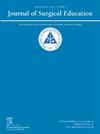Flexibility in Surgical Training Does Not Affect American Board of Surgery Board Eligibility or Certification: Long-term Outcomes from a Prospective, Multi-Institutional Study of General Surgery Residents
IF 2.6
3区 医学
Q1 EDUCATION, SCIENTIFIC DISCIPLINES
引用次数: 0
Abstract
OBJECTIVE
In 2011, the American Board of Surgery (ABS) implemented a policy to permit greater flexibility in the structure of general surgery (GS) residency training. Our goal was to investigate the impact of flexibility in surgical training (FIST) on resident success in obtaining ABS board eligibility and certification.
DESIGN
A prospective, multi-institutional study was conducted to examine the feasibility of incorporating flexibility tracks across residency programs and measure educational outcomes including ABS In-service Training Exam (ABSITE) scores, Accreditation Council for Graduate Medical Education (ACGME) Milestones, operative case log volumes, and ABS Qualifying (QE) and Certifying (CE) Examinations scores. We compared residents participating in flexibility tracks (“FIST residents”) to contemporaneous residents not involved in subspecialty tracks (“non-FIST residents”).
SETTING
Seven academic GS residency programs.
PARTICIPANTS
GS residents at participating institutions were granted the opportunity to customize up to 12 of the final 24 months of residency with subspecialty rotations.
RESULTS
From 2013 to 2019, 186 (52.2%) of 356 residents participated in a flexibility track. The most frequently selected subspecialty tracks were hepatobiliary (26.9%), gastrointestinal (15.1%), and cardiothoracic surgery (15.1%). There were no significant differences in ABSITE scores (573.0 vs. 562.0; p = 0.191) or total major operations performed (1056.5 vs 1018.0; p = 0.074) between FIST and non-FIST post-graduate year 5 residents. Residents participating in FIST scored significantly higher on 15 of 16 ACGME Milestones when compared to non-FIST residents. The first-time pass rate for the ABS QE was 92.2% and 91.1% for FIST and non-FIST residents, respectively (p = 0.756). The first-time pass rate for the ABS CE was 85.8% and 83.6% for FIST and non-FIST residents, respectively (p = 0.687). Overall, FIST residents had a higher first-time pass rate on both the QE (92.2% vs. 90.6%) and CE (85.8% vs. 81.7%), when compared to the national average.
CONCLUSIONS
Despite spending more time on subspecialty-focused flexible rotations, residents participating in FIST perform similarly to their peers in multiple measures, including on the ABS QE and CE. Incorporating integrated subspecialty training within GS residency does not interfere with the future success of trainees in obtaining ABS board certification. These findings could help inform modifications to the structure of surgical training, including allowing for earlier entry into subspecialty training.
外科培训的灵活性不影响美国外科委员会的资格或认证:一项前瞻性、多机构的普外科住院医师研究的长期结果。
目的:2011年,美国外科委员会(ABS)实施了一项政策,允许在普通外科(GS)住院医师培训的结构上有更大的灵活性。我们的目标是调查外科培训灵活性(FIST)对住院医师成功获得ABS委员会资格和认证的影响。设计:进行了一项前瞻性、多机构研究,以检验在住院医师项目中纳入灵活性跟踪的可行性,并衡量教育成果,包括ABS在职培训考试(ABSITE)分数、研究生医学教育认证委员会(ACGME)里程碑、手术病例日志量和ABS资格(QE)和认证(CE)考试分数。我们比较了参与灵活路径的居民(“FIST居民”)和未参与亚专业路径的同期居民(“非FIST居民”)。设置:7个学术GS住院医师项目。参与者:参与机构的GS住院医生有机会在最后24个月的住院医生实习期中进行多达12个专科的轮岗。结果:2013 - 2019年,356名居民中有186人(52.2%)参加了弹性轨道。最常选择的亚专科是肝胆外科(26.9%)、胃肠外科(15.1%)和心胸外科(15.1%)。ABSITE评分差异无统计学意义(573.0 vs 562.0;P = 0.191)或总主要手术(1056.5 vs 1018.0;p = 0.074)。与非FIST居民相比,参加FIST的居民在16个ACGME里程碑中的15个得分明显更高。拳头居民和非拳头居民对ABS QE的首次通过率分别为92.2%和91.1% (p = 0.756)。拳头居民和非拳头居民ABS CE的首次通过率分别为85.8%和83.6% (p = 0.687)。总体而言,与全国平均水平相比,拳头居民在量化宽松(92.2%对90.6%)和CE(85.8%对81.7%)中的首次通过率都更高。结论:尽管在以亚专科为重点的灵活轮转上花费了更多时间,但参加FIST的住院医生在多个指标上的表现与同行相似,包括ABS量化宽松和CE。在GS住院医师中纳入综合亚专业培训不会影响受训者未来获得ABS委员会认证的成功。这些发现有助于改变外科培训的结构,包括允许更早地进入亚专科培训。
本文章由计算机程序翻译,如有差异,请以英文原文为准。
求助全文
约1分钟内获得全文
求助全文
来源期刊

Journal of Surgical Education
EDUCATION, SCIENTIFIC DISCIPLINES-SURGERY
CiteScore
5.60
自引率
10.30%
发文量
261
审稿时长
48 days
期刊介绍:
The Journal of Surgical Education (JSE) is dedicated to advancing the field of surgical education through original research. The journal publishes research articles in all surgical disciplines on topics relative to the education of surgical students, residents, and fellows, as well as practicing surgeons. Our readers look to JSE for timely, innovative research findings from the international surgical education community. As the official journal of the Association of Program Directors in Surgery (APDS), JSE publishes the proceedings of the annual APDS meeting held during Surgery Education Week.
 求助内容:
求助内容: 应助结果提醒方式:
应助结果提醒方式:


